Introduction
A pivotal event in Indian history, the Battle of Plassey, which took place on June 23, 1757, signaled the start of British colonial rule. India’s political and economic landscape was changed by this crucial battle between Siraj-ud-Daulah, the Nawab of Bengal, and Robert Clive‘s British East India Company. The victory established the British East India Company as a dominant force in Bengal, paving the way for nearly two centuries of British rule.
This battle is significant not just for its military outcome but for its far-reaching implications. It symbolized the exploitation of internal divisions within Indian rulers, the use of strategic betrayals, and the eventual subjugation of Indian sovereignty. The British victory at Plassey was not solely a military triumph; it also reflected their mastery in diplomacy and manipulation, setting a precedent for their future conquests in India.
Understanding the context and significance of the Battle of Plassey provides crucial insights into how colonialism took root in India, and how it shaped the nation’s socio-political fabric for generations to come.
Historical Context
Background of Bengal in the Mid-18th Century
Prosperity and Strategic Importance
During the mid-18th century, Bengal was one of the wealthiest and most prosperous regions in India. Its fertile lands, extensive trade networks, and flourishing industries, particularly in textiles, made it a jewel in the subcontinent. Bengal’s economic strength attracted the attention of European powers vying for dominance in India, including the British and the French. The region’s strategic location, with access to the Bay of Bengal and major river systems, made it a critical hub for trade and military operations.
Bengal’s affluence was matched by its political significance. As a major province of the declining Mughal Empire, Bengal held considerable autonomy under its Nawab. This combination of wealth and political leverage made Bengal a prime target for European trading companies seeking to expand their influence.
Nawab Siraj-ud-Daulah’s Rule
Siraj-ud-Daulah ascended to the throne of Bengal in 1756 at a young age, succeeding his grandfather, Alivardi Khan. His reign was marked by ambition but also by challenges, including internal dissent and the growing interference of European powers. Siraj-ud-Daulah resented the increasing assertiveness of the British East India Company, which had fortified its trading posts, bypassed local governance, and undermined the Nawab’s authority.
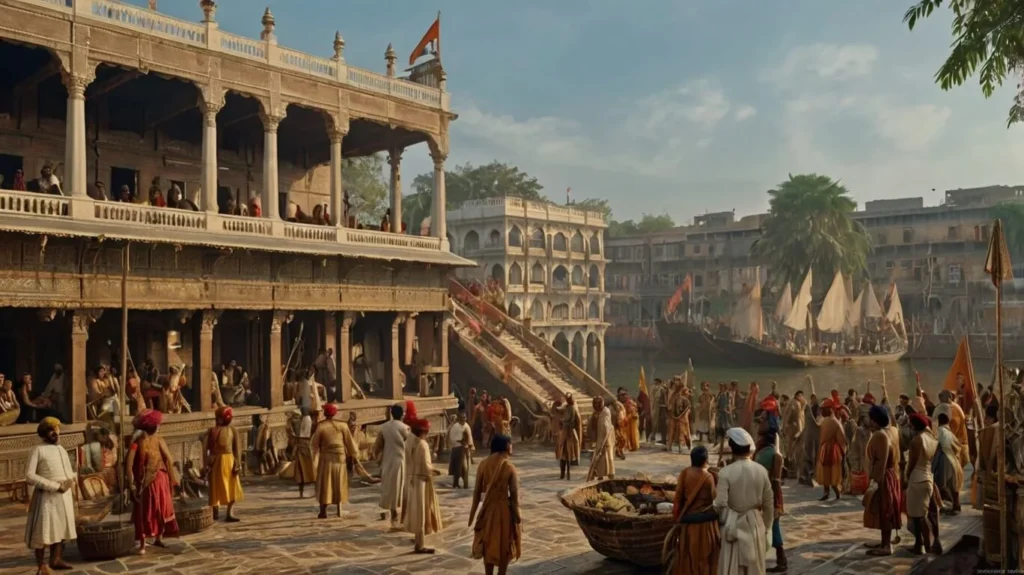
The Nawab’s confrontational stance towards the British was a response to their defiance of his orders and their refusal to pay adequate taxes. However, his rule was weakened by a lack of unity among his courtiers and the opportunism of figures like Mir Jafar, who later played a key role in his downfall. Siraj’s inability to consolidate his power made him vulnerable to the East India Company’s machinations.
Rising Influence of European Trading Companies
East India Company’s Growing Ambitions
The British East India Company, initially established for trade, had transformed into a political and military entity by the mid-18th century. Its growing ambitions were evident in its attempts to dominate trade routes, secure tax exemptions, and fortify its positions in Bengal. These actions not only provoked the Nawab but also signaled the Company’s intent to move beyond commerce and establish territorial control.
The Company’s leadership, particularly under figures like Robert Clive, recognized Bengal’s strategic and economic value. Securing Bengal would provide a steady revenue stream to fund their military and administrative expansions in other parts of India. The Company’s calculated moves were aimed at exploiting local weaknesses to achieve their imperial objectives.
French and British Rivalry in India
The mid-18th century was also a period of intense rivalry between the French and British in India, driven by their broader conflict in Europe during the Seven Years’ War (1756–1763). Both powers sought to expand their influence in India by aligning with local rulers and supporting rival factions.
In Bengal, the French presence posed a challenge to the British East India Company, as both sought alliances with Indian rulers to counter each other. The Nawab’s dissatisfaction with British actions initially led him to engage with the French, further escalating tensions. This rivalry played a significant role in the unfolding of the Battle of Plassey, as the British sought to eliminate French influence to secure their dominance in Bengal.
This historical context sets the stage for understanding the causes, events, and consequences of the Battle of Plassey. It highlights the interplay of local and international forces that shaped this transformative episode in Indian history.
The Prelude to the Battle of Plassey
On June 23, 1757, a complicated web of political rivalries, economic interests, and personal goals culminated in the Battle of Plassey. To fully understand the events that unfolded on the battlefield, it is crucial to examine the prelude to the battle, which was shaped by deep-rooted conflicts and strategic maneuvering by key players.
Causes of Conflict
The Function of Betrayals and Political Alliances
The mid-18th century in Bengal was characterized by political instability, with the Nawab’s court rife with factionalism and intrigue. Siraj-ud-Daulah, the young Nawab of Bengal, faced opposition from within his court, where many of his senior officials and military commanders harbored resentment against him.
- Factionalism in the Nawab’s Court: Prominent nobles like Mir Jafar, Yar Lutuf Khan, and Rai Durlabh played duplicitous roles. Displeased with Siraj’s leadership style, they conspired with the British East India Company, which promised them power and wealth in exchange for their support in overthrowing the Nawab.
- British Exploitation of Divisions: The British East India Company, under Robert Clive, capitalized on these internal divisions. By forming secret alliances with discontented court members, they undermined Siraj’s authority and laid the groundwork for their eventual victory. This strategy of fostering betrayal would become a hallmark of British colonial expansion in India.
The battle’s result was largely determined by the betrayal of Siraj-ud-Daulah’s major supporters. These included Mir Jafar, who was promised the position of Nawab by the British, withdrew his troops during the Battle of Plassey, leaving Siraj’s forces vulnerable. The other included Jagat Seth, Omi Chand and Rai Durlabh.
Siraj-ud-Daulah’s Resentment Against British Fortifications at Fort William
One of the primary triggers of the conflict was Siraj-ud-Daulah’s anger over the British East India Company’s unauthorized fortifications at Fort William in Calcutta (now Kolkata).
- Perceived Threat to Sovereignty: The Company’s fortifications were seen by Siraj-ud-Daulah as an outright challenge to his power. The British had reinforced Fort William and increased their military presence under the pretext of protecting their trade interests during the ongoing conflict with the French. However, the Nawab saw this as a violation of his sovereignty and an act of defiance against his rule.
- The Siege of Calcutta: Siraj-ud-Daulah commanded his army in the conquest of Calcutta in June 1756. The British defenders were unprepared, and the Nawab’s forces quickly overwhelmed the fort, leading to the infamous incident later referred to as the “Black Hole of Calcutta.” While this incident was likely exaggerated by British accounts, it fueled animosity and provided a justification for the Company’s military retaliation.
This event set the stage for the confrontation at Plassey, as the British sought to reclaim Calcutta and reassert their influence in Bengal.
Key Players
Siraj-ud-Daulah

Siraj-ud-Daulah, the last independent Nawab of Bengal, was a central figure in the events leading up to the Battle of Plassey.
- Youth and Ambition: At just 23 years old, Siraj ascended to the throne, inheriting a kingdom facing internal dissent and external threats. Despite his youth and inexperience, he was determined to assert his authority and protect Bengal’s sovereignty.
- Challenges to His Leadership: Siraj’s autocratic style and tendency to alienate key courtiers created an environment of distrust within his court. This internal opposition proved fatal, as many of his allies, including Mir Jafar, betrayed him during the battle.
- Symbol of Resistance: Despite his defeat, Siraj is remembered as a symbol of resistance against British expansion. His downfall marked the beginning of the end for independent Indian rulers in the face of colonial ambitions.
Robert Clive and the East India Company
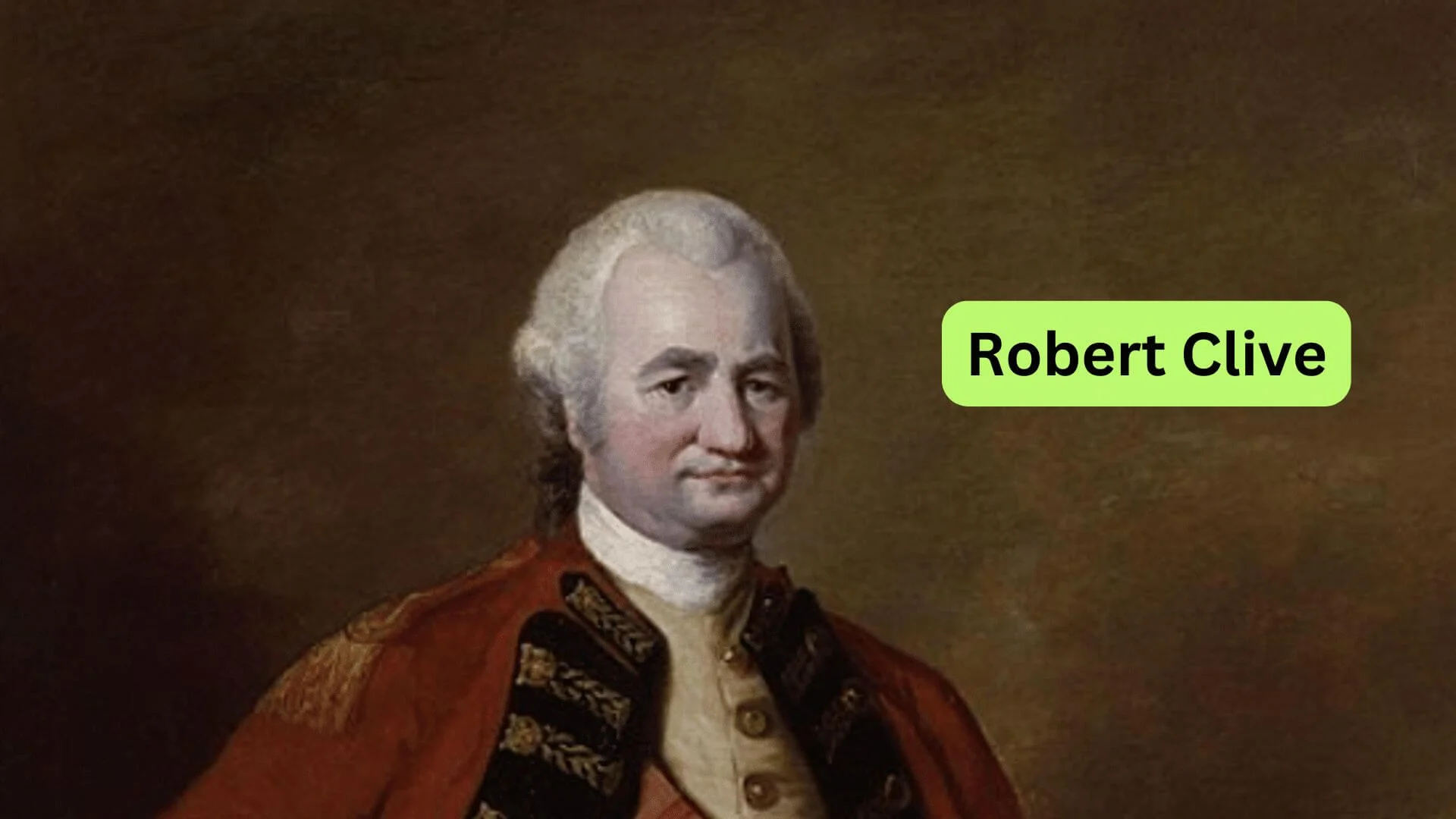
Robert Clive, a key architect of British dominance in India, played a pivotal role in orchestrating the events that led to the Battle of Plassey.
- Military Strategy: Clive was a skilled strategist who understood the importance of combining military force with political maneuvering. His ability to exploit divisions within the Nawab’s court was instrumental in securing the British victory.
- Diplomatic Tactics: Clive negotiated secret agreements with key figures in Siraj’s court, including Mir Jafar, to ensure their support during the battle. This combination of diplomacy and deception was a hallmark of Clive’s approach.
- Legacy: Clive’s success at Plassey established the British East India Company as a dominant power in India. His actions not only secured Bengal but also laid the foundation for British imperial rule in the subcontinent.
Mir Jafar and Other Conspirators
The Nawab’s demise was largely due to Mir Jafar, a key commander in Siraj-ud-Daulah’s army.
- Ambition and Betrayal: Disillusioned with Siraj’s rule, Mir Jafar conspired with the British, who promised to make him the next Nawab. During the Battle of Plassey, he deliberately held back his forces, tipping the scales in favor of the British.
- Puppet Leadership: After Siraj’s defeat, Mir Jafar was installed as the Nawab of Bengal. However, his reign was marked by British control, as he served as a figurehead while the Company exercised real power.
- Impact of Betrayal: Mir Jafar’s betrayal set a precedent for the British strategy of using Indian intermediaries to govern indirectly. This system allowed the Company to consolidate its power while minimizing resistance from local rulers.
Other key conspirators, such as Rai Durlabh and Jagat Seth (a wealthy banker), also played roles in undermining Siraj’s rule. Their involvement highlights how economic and political interests converged to facilitate the British victory.
The prelude to the Battle of Plassey underscores the interplay of internal weaknesses and external manipulations that led to one of the most significant turning points in Indian history. The betrayal of Siraj-ud-Daulah by his own allies, coupled with the British East India Company’s strategic cunning, ensured a victory that reshaped the political landscape of India for generations.
The Battle of Plassey
The Battle of Plassey, fought on June 23, 1757, near the village of Plassey (modern-day Palashi in West Bengal), was a defining moment in Indian history. It marked the beginning of British colonial dominance in India and symbolized the devastating consequences of internal divisions and external manipulation. Below is a detailed exploration of the events and dynamics that unfolded during this critical confrontation.
Date and Location
- Date: June 23, 1757.
- Location: The battle took place along the banks of the Bhagirathi River, near the village of Plassey in Bengal.
- Significance of the Location: The lush terrain, interspersed with mango groves and the river, provided natural advantages and challenges to both sides. The site’s proximity to key trading routes made it strategically important for controlling the Bengal region.
Troop Strengths and Disparities
One of the striking aspects of the Battle of Plassey was the significant disparity in the troop strengths of the two sides.
| The Nawab’s Forces | ||
|---|---|---|
| Numbers | Siraj-ud-Daulah commanded a formidable force of approximately 50,000 troops, which included infantry, cavalry, and artillery units. | The British East India Company, under Robert Clive, had a significantly smaller force of 3,000 troops. |
| Composition | 1. Infantry: About 40,000 foot soldiers. 2. Cavalry: Around 10,000 mounted troops. 3. Artillery: Over 50 cannons, some of which were large and immobile. | 1. 2,100 Indian sepoys (locally recruited soldiers). 2. 900 European soldiers. 3. Artillery: The British had just a few cannons, but they were mobile and expertly handled. |
| Challenges/Strengths | Despite the numerical superiority, the Nawab’s forces lacked cohesion and morale, primarily due to internal divisions and the betrayal by key commanders such as Mir Jafar. | 1. Superior training and discipline. 2. Modern weaponry and effective leadership. |
| Support | Mir Jafar, Rai Durlabh, OmiChand and Jagat Seth promised to support but later betrayed. | The British also had secret backing from Mir Jafar and other conspirators, which undermined the Nawab’s efforts. |
Strategic Decisions
The outcome of the Battle of Plassey was influenced heavily by strategic decisions, the prevailing weather, and the betrayal within Siraj-ud-Daulah’s ranks.
The Role of Weather and Faulty Tactics by Siraj-ud-Daulah
- Weather Conditions: Heavy rains lashed the battlefield on the morning of June 23, 1757. While the British protected their ammunition by using tarpaulins, the Nawab’s forces failed to safeguard their supplies, rendering much of their gunpowder useless.
- This oversight left Siraj’s artillery ineffective and significantly weakened his army’s firepower.
- Siraj’s Tactical Errors
- Lack of Coordination: Siraj-ud-Daulah struggled to command his diverse and divided forces effectively. His army lacked a unified strategy, with different factions acting independently.
- Defensive Posture: Instead of launching a decisive offensive against the smaller British force, Siraj chose a defensive approach, allowing Clive to dictate the terms of engagement.
- Underestimating the British: Siraj underestimated the British ability to exploit his weaknesses, both militarily and politically.
Mir Jafar’s Betrayal and Its Impact
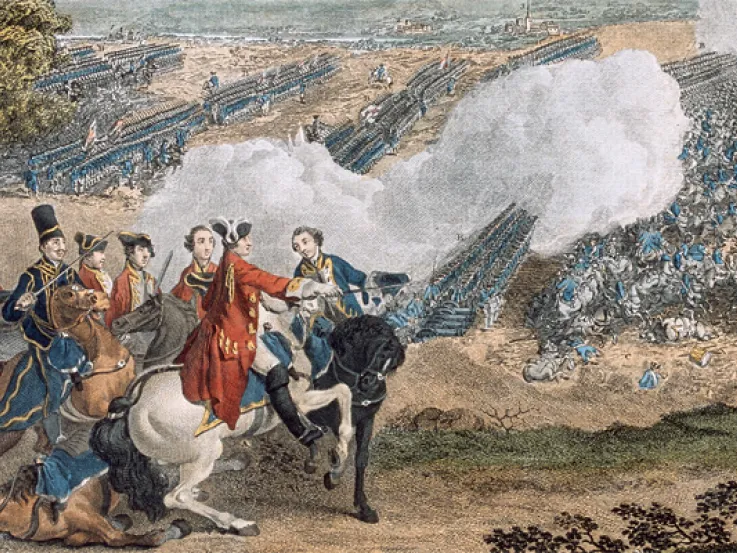

 National Army Museum
National Army Museum- The Betrayal
- Mir Jafar, the commander of a significant portion of the Nawab’s army, had secretly allied with Robert Clive in exchange for a promise to be installed as the next Nawab of Bengal.
- During the battle, Mir Jafar deliberately held back his troops, refusing to engage in combat and leaving Siraj’s forces vulnerable.
- Psychological Impact
- The betrayal demoralized Siraj’s troops and sowed confusion within his ranks. Many soldiers either fled the battlefield or surrendered without putting up significant resistance.
- The Nawab’s trust in his commanders was shattered, further eroding his ability to lead effectively.
- Tactical Consequences
- The British, although outnumbered, were able to outmaneuver and overpower Siraj’s weakened forces, turning the tide of the battle in their favor.
- Mir Jafar’s inaction ensured that the Nawab’s army could not capitalize on its numerical advantage, sealing Siraj’s fate.
Robert Clive’s Strategic Brilliance
- Bold Leadership: Clive demonstrated exceptional leadership by maintaining discipline among his troops and leveraging his smaller, more agile force to exploit the weaknesses in the Nawab’s army.
- Effective Alliances: Clive’s ability to secure alliances with disgruntled members of Siraj’s court, such as Mir Jafar, played a pivotal role in neutralizing the Nawab’s numerical superiority.
- Use of Terrain: Clive positioned his troops strategically within the mango groves, using the natural cover to shield his forces from enemy fire while launching coordinated attacks.
The Battle of Plassey was not a conventional military engagement but rather a carefully orchestrated campaign of political manipulation and strategic opportunism. While Siraj-ud-Daulah’s forces held numerical superiority, their disunity and the betrayal by key allies proved catastrophic. The British, led by Robert Clive, combined military skill with political cunning to secure a decisive victory, laying the foundation for nearly two centuries of colonial rule in India.
Aftermath and Consequences of the Battle of Plassey
The aftermath of the Battle of Plassey in 1757 not only reshaped the political landscape of Bengal but also laid the foundation for the British domination of India. The immediate effects were dramatic, with a swift change in leadership and the beginning of large-scale exploitation. Over the long term, the battle significantly altered India’s history, paving the way for the establishment of the British Raj.
Immediate Effects
Siraj-ud-Daulah’s Capture and Execution
- Defeat and Flight: After the crushing defeat at Plassey, Siraj-ud-Daulah fled to Murshidabad, his capital, in an attempt to regroup or escape. However, his betrayal by allies and widespread desertions left him vulnerable.
- Capture: Siraj was captured by forces loyal to Mir Jafar and the East India Company. His former allies, including his own confidants, turned against him.
- Execution: Siraj-ud-Daulah was executed on July 2, 1757, on the orders of Mir Jafar, marking the end of his short but turbulent reign. His death symbolized the tragic downfall of Bengal’s independence and sovereignty.
Mir Jafar’s Installation as Puppet Nawab
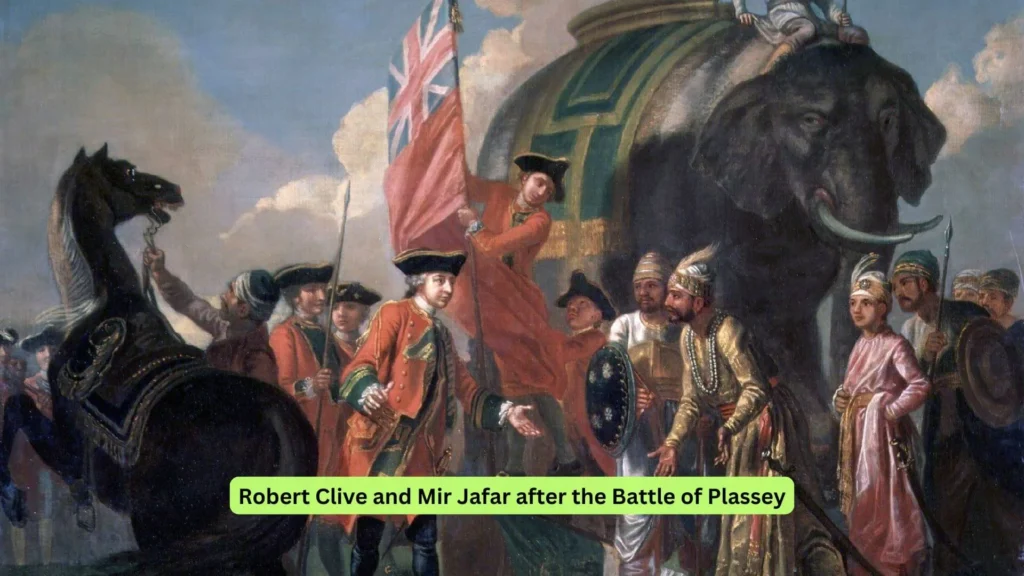
- Ascension to Power: Mir Jafar, one of Siraj-ud-Daulah’s key commanders who betrayed him during the battle, was installed as the new Nawab of Bengal by the British. His ascension was the result of a pre-battle agreement with Robert Clive and the East India Company.
- Puppet Leadership
- Although nominally the ruler of Bengal, Mir Jafar was entirely subservient to the British.
- He ceded significant territories and trade privileges to the East India Company, effectively relinquishing much of Bengal’s autonomy.
- Financial Payments
- As part of the deal, Mir Jafar agreed to pay enormous sums of money to the British as “compensation” for the costs of war.
- This financial burden crippled Bengal’s economy and marked the beginning of systematic economic exploitation by the British.
Long-Term Impact
The consequences of the Battle of Plassey extended far beyond its immediate aftermath, profoundly influencing the history and trajectory of India for the next two centuries.
Consolidation of British Power in Bengal
- Control Over Bengal: The victory at Plassey gave the East India Company direct control over Bengal’s resources and revenues. This control grew stronger over time, especially after the Battle of Buxar in 1764.
- Strategic Expansion
- The British used Bengal as a base to expand their influence across the rest of India.
- The consolidation of power in Bengal allowed the Company to fund military campaigns and administrative structures, accelerating their territorial expansion.
- Decline of Mughal Authority: The defeat of Siraj-ud-Daulah weakened the already declining Mughal Empire, as British power began to overshadow traditional Indian rulers.
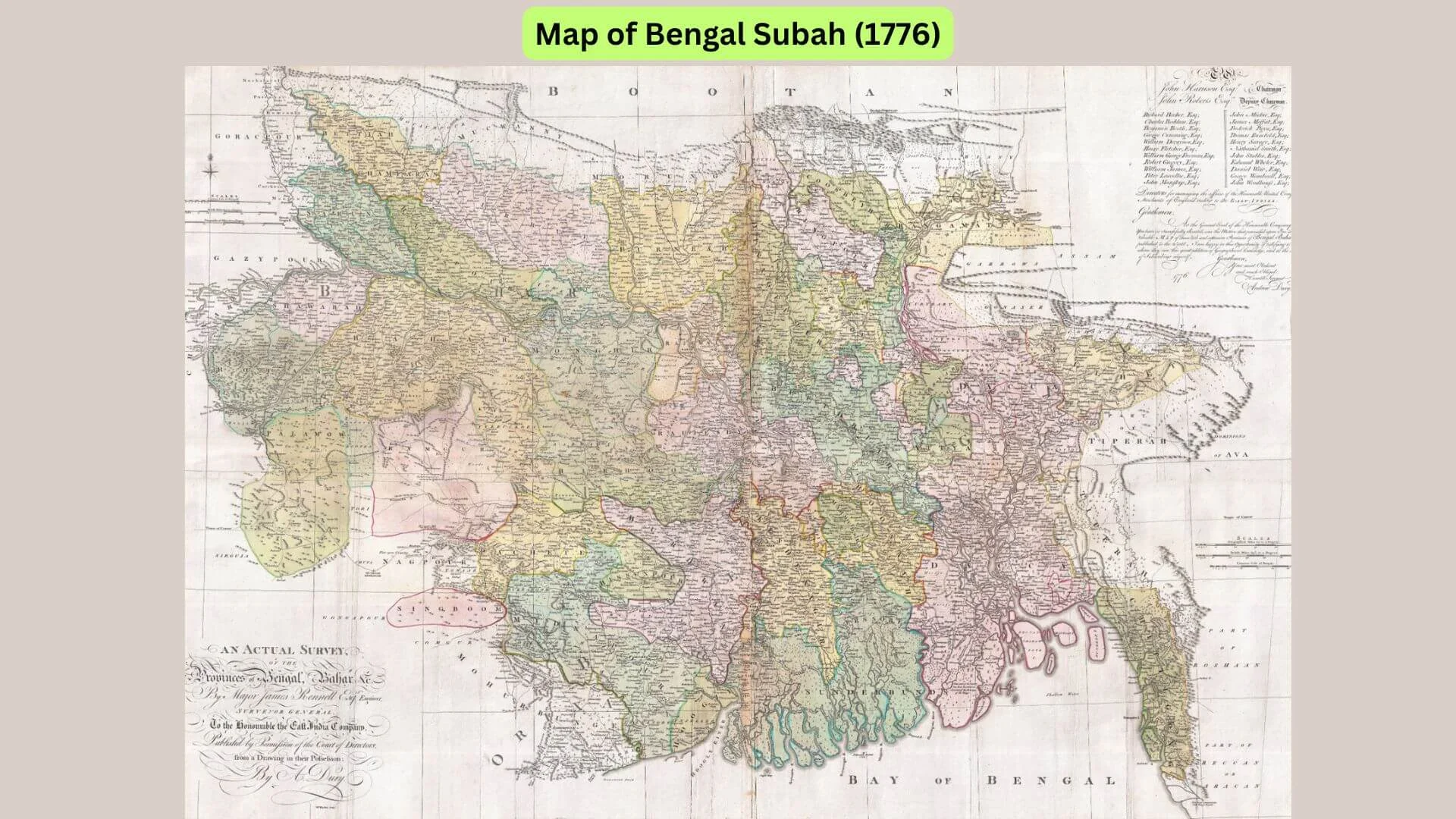
Economic Exploitation and Political Control
- Drain of Wealth
- The systematic extraction of wealth from Bengal to Britain began in earnest after the battle.
- Heavy taxation and exploitation of Bengal’s resources devastated its economy, leading to widespread poverty and famines.
- The 1770 Bengal Famine, which caused millions of deaths, was a direct consequence of the economic policies implemented by the British after their takeover.
- Monopoly Over Trade: The East India Company established monopolies over key goods such as textiles, salt, and indigo, further crippling local industries and artisans.
- Erosion of Local Governance
- The British sidelined traditional Indian institutions, replacing them with systems that prioritized their economic and administrative interests.
- Bengal’s governance became increasingly centralized under the Company’s control, diminishing the role of local rulers and elites.
Establishment of the Foundation for the British Raj
- Political Domino Effect
- The victory at Plassey set a precedent for using military might combined with political manipulation to subjugate Indian states.
- It marked the beginning of a new era in Indian history, where the British systematically dismantled regional powers to establish their dominance.
- Transition to Formal Colonial Rule
- By 1858, following the Indian Rebellion of 1857, the British Crown assumed direct control of India, formalizing the British Raj.
- The administrative, military, and economic foundations laid in Bengal after Plassey were critical to the establishment of British colonial rule.
- Cultural Impact
- The growing British presence in Bengal became a catalyst for cultural and social change.
- While some educational reforms and infrastructure development occurred, these were primarily designed to serve British interests.
Historical Significance
The Battle of Plassey was not just a military engagement but a turning point in Indian history. It demonstrated the devastating consequences of internal divisions and betrayal, as well as the effectiveness of British strategic maneuvering.
- Legacy in Indian History
- The battle is often regarded as the beginning of the end of traditional Indian sovereignty.
- It serves as a stark reminder of the dangers of political disunity and external interference.
- Lessons for the Future: The events leading up to and following the battle highlight the importance of unity and resilience in the face of external threats.
The aftermath of the Battle of Plassey transformed Bengal from one of the wealthiest regions in the world into a symbol of colonial exploitation. The immediate effects of Siraj-ud-Daulah’s downfall and Mir Jafar’s rise, coupled with the long-term consequences of British control, marked the beginning of a dark chapter in Indian history. This battle was a crucial milestone in the establishment of British colonial rule, leaving a legacy that continues to shape the discourse on India’s colonial past.
Legacy of the Battle of Plassey
The Battle of Plassey, fought on June 23, 1757, not only marked a pivotal moment in Indian history but also left a complex and far-reaching legacy. Its impact extended beyond the immediate political and military shifts, influencing the social, economic, and cultural landscape of India for centuries. The betrayal at Plassey remains a subject of historical scrutiny, while the battle itself stands as a key milestone in the transition from Mughal dominance to British colonial rule.
Perspectives on the Betrayal
Historical Debates Around Mir Jafar’s Role
- The Betrayer of Bengal
- Mir Jafar, a senior commander in Siraj-ud-Daulah’s army, is widely regarded as one of the most infamous traitors in Indian history. His defection to the British during the battle was decisive in ensuring their victory.
- Mir Jafar’s collaboration with Robert Clive was not born of altruism but of personal ambition. He sought the Nawabship of Bengal in exchange for aiding the British.
- Conflicting Views
- While many historians criticize Mir Jafar for his betrayal, some argue that his actions were a reflection of the fractured political environment of the time.
- The Nawab’s court was rife with internal divisions, and Mir Jafar’s decision could be seen as an opportunistic move in a highly volatile situation.
- Symbol of Political Opportunism: Mir Jafar’s role is often cited as a cautionary tale of how internal treachery can undermine national sovereignty. His legacy remains synonymous with betrayal in Indian historical discourse.
Views of Siraj-ud-Daulah as a Symbol of Resistance
- A Young and Controversial Leader
- Siraj-ud-Daulah ascended to power at the young age of 23 and faced immense challenges, including managing a court filled with conspirators and countering the growing ambitions of European trading companies.
- His resistance to British fortifications at Fort William and his attempts to curb foreign interference reflect his determination to protect Bengal’s sovereignty.
- A Symbol of Anti-Colonial Struggle
- Despite his defeat, Siraj-ud-Daulah is often seen as a martyr who stood against the colonial ambitions of the British.
- In modern Indian nationalist narratives, he is celebrated as a symbol of resistance against foreign domination.
- Complex Legacy
- Siraj’s reign was marked by both bravery and political naivety. While he sought to protect Bengal’s independence, his inability to navigate the court’s politics and counter the British strategy ultimately led to his downfall.
Impact on Indian Society and Economy
Transition from Mughal Influence to British Colonial Rule
- Decline of Mughal Power
- The Battle of Plassey marked a significant decline in Mughal influence in Bengal and, by extension, across India.
- While the Mughal Empire had been waning for decades, the British victory at Plassey accelerated this process by reducing the authority of regional rulers who were nominally under Mughal control.
- Rise of the British East India Company
- Plassey allowed the East India Company to consolidate its power in Bengal, which became a stepping stone for its expansion into other parts of India.
- The Company transitioned from being a trading entity to a political force, wielding unprecedented control over Bengal’s administration and resources.
- Shift in Governance
- The traditional systems of governance and justice under Mughal rule were gradually replaced by British administrative structures.
- This shift laid the foundation for the centralized governance that characterized British colonial rule.
Economic Impact on Bengal and India
- Exploitation of Bengal’s Resources
- Following their victory, the British implemented policies designed to extract wealth from Bengal to finance their operations in India and beyond.
- The infamous “drain of wealth” began, as Bengal’s resources and revenues were redirected to Britain, crippling its once-thriving economy.
- Decline of Indigenous Industries
- The East India Company’s monopolistic practices led to the destruction of traditional industries, particularly Bengal’s world-renowned textile sector.
- Artisans and weavers were forced into poverty as British policies favored the import of goods from England.
- Impact on Agriculture
- Heavy taxation and revenue demands placed immense pressure on Bengal’s agrarian economy.
- The exploitation of peasants and farmers led to widespread distress and contributed to catastrophic events like the Bengal Famine of 1770.
- Foundation of Economic Colonialism
- The economic policies initiated after Plassey became a blueprint for British exploitation across India, ensuring that colonial rule was financially beneficial to Britain at India’s expense.
Cultural and Social Ramifications
- Erosion of Local Identity
- The influx of British culture and governance began to alter the socio-cultural fabric of Bengal.
- Traditional systems of education, art, and governance were sidelined in favor of British models.
- Birth of Resistance Movements
- Over time, the economic and social hardships caused by British rule sowed the seeds of resistance.
- The legacy of Plassey became a rallying point for later generations of Indian nationalists who sought to overthrow colonial rule.
Historical and Modern Reflections
- A Defining Moment in Indian History: The Battle of Plassey is widely seen as the beginning of British colonial rule in India. Its consequences were felt not only in Bengal but throughout the subcontinent.
- Lessons from Plassey:
- The betrayal and internal divisions that contributed to the British victory at Plassey serve as a reminder of the importance of unity in the face of external threats.
- The exploitation that followed underscores the dangers of allowing foreign powers unchecked access to a nation’s resources.
The legacy of the Battle of Plassey is a multifaceted one, encompassing themes of betrayal, resistance, and exploitation. It symbolizes both the fragility of political alliances and the resilience of those who sought to defend their homeland. The conflict established the foundation for India’s eventual independence even if it also signaled the start of a period of colonial domination. The events of Plassey continue to evoke a mix of introspection and inspiration, making it one of the most significant chapters in Indian history.
Lessons from History
The Battle of Plassey, fought in 1757, holds enduring lessons that resonate across centuries. Beyond its immediate military and political outcomes, the event serves as a case study in understanding imperialism, the impact of internal divisions, and the long-term implications for sovereignty and nation-building. By reflecting on these lessons, we can better comprehend the dynamics of colonialism and draw insights for modern governance and unity.
Understanding Imperialism and Its Effects
- Imperialism as a System of Control
- The Battle of Plassey marked the early stages of British imperial dominance in India.
- It illustrates how economic interests—initially tied to trade—transitioned into political and territorial control.
- The East India Company’s exploitation of Bengal’s wealth not only established Britain’s supremacy but also left a legacy of economic underdevelopment in India.
- Economic Subjugation
- The policies imposed by the British after Plassey introduced a system of economic colonialism.
- These policies prioritized the extraction of resources and wealth for the benefit of the colonizer, leaving local economies in decline.
- Cultural and Social Impact
- Imperialism disrupted traditional social structures and cultural practices.
- The imposition of British education, laws, and governance systems replaced indigenous institutions, altering the societal fabric of Bengal and beyond.
Role of Internal Division in Weakening Sovereignty
- The Danger of Betrayal and Disunity
- The betrayal by Mir Jafar and other conspirators highlights how internal divisions can undermine national sovereignty.
- Siraj-ud-Daulah’s downfall was not solely due to British strategy but also to the fractured loyalties within his court.
- Lessons for Modern Governance
- Unity among leaders and stakeholders is crucial to safeguarding sovereignty against external threats.
- Plassey serves as a warning about the consequences of prioritizing personal gain over collective national interests.
- Historical Repetition: Similar instances of internal betrayal have recurred throughout history, underscoring the need for vigilance against divisive forces within a nation.
Legacy in Modern Indian History and Nationalism
- Inspiration for Resistance Movements
- While Plassey marked the beginning of British rule, it also became a symbol of resistance against colonial oppression.
- Indian leaders and freedom fighters often invoked the battle as a cautionary tale, urging unity in the struggle for independence.
- Foundation for National Identity
- The events of Plassey contributed to the rise of a collective national consciousness.
- Over time, the injustices and exploitation that followed the battle galvanized Indians to demand self-rule and economic justice.
- A Lasting Symbol in Historical Memory
- The battle’s legacy is deeply embedded in Indian education, literature, and culture.
- It serves as a reminder of the resilience of those who fought against imperialism and the importance of learning from past mistakes.
Conclusion
One of the pivotal events in Indian history is the Battle of Plassey. It marked the transition from a prosperous and semi-autonomous Bengal to a colony under British dominance. The events of Plassey were not just a military engagement but a turning point that reshaped the subcontinent’s political, economic, and cultural trajectory.
The battle’s consequences extended far beyond the battlefield, laying the foundation for nearly two centuries of British rule. Its legacy serves as both a warning and an inspiration: a warning about the dangers of disunity and imperial exploitation, and an inspiration for the resilience and eventual triumph of the Indian people in reclaiming their sovereignty.

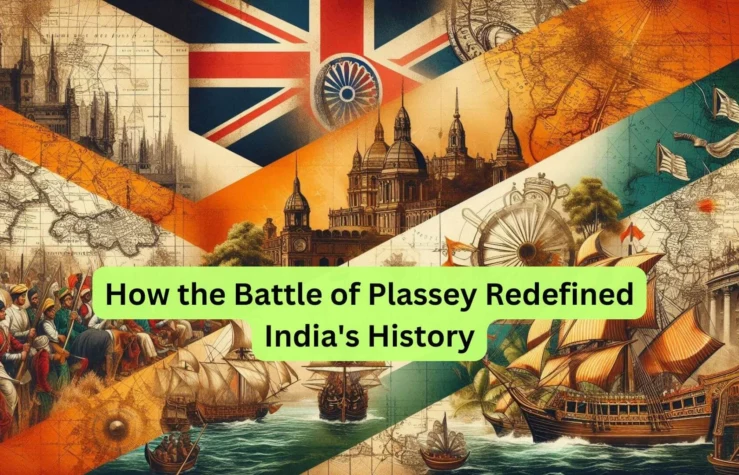

1 Comment